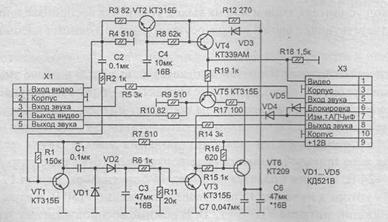Answer the question
In order to leave comments, you need to log in
How is it possible to determine if the device is turned on by the signal at the RCA output?
In general, there are two devices that output video via RCA output, and there is a TV that accepts only RCA input.
So, is it possible to safely and without creating noise on the signal determine whether the device is turned on by the signal at the RCA video output (the devices will be connected to a certain switcher that will be used to auto-switch to the turned on device)?
It would also be nice to similarly determine whether the TV is turned on (if possible, of course), provided that no devices are connected to its RCA output at the time of measurement.
And yes, I will use Arduino to process the results, so if there is a possibility of a more software than physical implementation of such a check, then it is better to describe it.
Answer the question
In order to leave comments, you need to log in
There are specialized microcircuits for working with analog video signals.
For example, EL4583 is perfect, it just knows how to detect the presence of a signal, or LM1881, it can pull out the clock signal from the video input, you can monitor the clock signal pulses, there are pulses - there is video.
True, this will not help if a "blue screen" is transmitted and they are already difficult to find on sale.
And to switch signals, you can use something like AD8184ARZ
Well, as usual, you can buy a finished device from the Chinese, something like https://www.aliexpress.com/item/4000022576355.html
In general, such a task often happens to motorists, the screen one, but there can be many cameras.
It is quite possible to determine the frame scan by the clock pulses.
The video signal has an amplitude of up to 1 volt, so you can measure it using an ADC or an analog comparator.
In this case, there is no need to measure with some crazy frequency. Just measure 10 times per second. If at least one count was greater than 0.2 V, then there is a signal. If during a certain number of measurements the voltage has never been more than 0.2 V, then there is no signal.
Purely programmatically, without physical devices - nothing.
In short, block - then an amplifier, integrator, comparator - the output will be log.0 / 1 - no or there is a signal.
In principle, on a transistor and one comparator, plus small things can be done, or even simpler, but less reliable. I once put a similar detector at the input on a home-made sound amplifier - the amplifier turns on with one non-fixed button, the relay trips, the circuit goes into self-locking and looks for the presence of a signal. As soon as any signal comes, the capacitor is charged, in the absence of it, it is discharged. When discharging below a certain level, the relay is released, the amplifier turns off. By time, I experimentally picked up the denominations so that the timeout would come out for about 20-30 minutes. The circuitry is mixed analog-discrete, but without any processors, ardiunos and even without any counters, at most simple logic like 2I-NOT, and there is only one trigger (it seems to have been for 12 years and I forgot how I did it there).
PS works and still, every day.
Look for the words of the video input automatic 3usct at the end of the last century, they did it to automatically switch the TV to the video input when a signal appeared. Several transistors, capacitor diodes. The key signal appeared at the blocking and changing t APCiF terminals. Such a scheme:
The first thing that comes to mind is to see if there is DC on the RCA inputs when the devices are running. If there is, by its presence it is possible to determine the fact of the operation of the device.
RCA usually transmits a video signal. The most logical thing is to catch video sync pulses, but arduino will not pull such a frequency (MHz).
Now, however, the digital standard, I do not know it, but there the frequency is no less.
Didn't find what you were looking for?
Ask your questionAsk a Question
731 491 924 answers to any question